

Online publication for school educators. You’ve probably heard the claim that you learn better when information is presented in your preferred ‘learning style’.
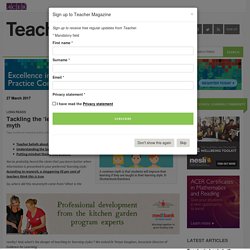
According to research, a staggering 95 per cent of teachers think this is true. So, where did this neuromyth come from? Mindfulness Is All the Rage—But Does It Work? Are your students stressed out, tired, and unable to focus?
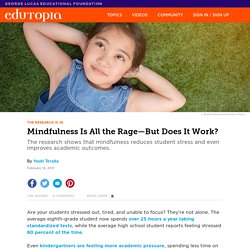
They’re not alone. The average eighth-grade student now spends over 25 hours a year taking standardized tests, while the average high school student reports feeling stressed 80 percent of the time. Even kindergartners are feeling more academic pressure, spending less time on art and music and more on math, reading, and assessment compared with the late 1990s. According to the American Academy of Pediatrics, childhood stress can lead to permanent changes in brain structure and function, increasing the likelihood of learning difficulties, memory problems, and chronic diseases in adult life.
Edutopia measuring sel download maurice elias. Mindfulness Is All the Rage—But Does It Work? Growth Mindset not the only tool for teachers — EducationHQ Australia. Everyone working in education searches for the elusive magic bullet; that one thing which will suddenly make all of our students open and receptive to the learning we are trying to impart.
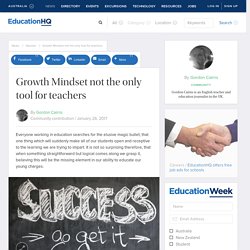
It is not so surprising therefore, that when something straightforward but logical comes along we grasp it, believing this will be the missing element in our ability to educate our young charges. The latest panacea to turn our pupils into high achievers is Growth Mindset. The thinking behind it is persuasive, arguing that intelligence is not fixed and can be developed through hard work and positive thinking to help you and your students to achieve their targets. If successfully applied in the classroom, the potential consequences could be incredible, imagine schools full of children surpassing what they thought they were previously capable of, which teacher wouldn't want to access a tool which could do that?
Teachers Need a Growth Mindset Too. For a teacher, it’s pretty easy to focus on improving students—that’s our job, right?
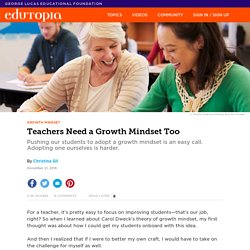
So when I learned about Carol Dweck’s theory of growth mindset, my first thought was about how I could get my students onboard with this idea. And then I realized that if I were to better my own craft, I would have to take on the challenge for myself as well. John Hattie's Eight Mind Frames For Teachers. “Hattie’s 8 Mind frames”.

Video scribe project by Cheryl Reynolds. In Visible Learning for Teachers (p. 159 ff) John Hattie claims that “the major argument in this book underlying powerful impacts in our schools relates to how we think! Praise The Process Build A Growth Mindset. Growth Mindset Deep Dive. Promoting growth mindset and effort in mathematics classrooms. In the second of two reader submissions about the Motivated Minds partnership between La Salle Academy Lithgow and Charles Sturt University, Associate Professor Jane Mitchell, Associate Professor Sara Murray and Jeffrey Larsen share a feedback strategy to encourage students to make a consistent effort in mathematics class, and to help them see a connection between their effort and achievement.
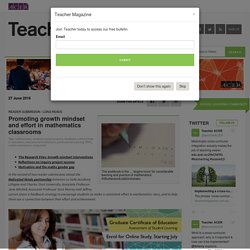
Students with a fixed mindset believe that intelligence or ability is an unchangeable entity; while those with a growth mindset think of intelligence or ability as a malleable quality that can be incrementally developed through effort. Students with a fixed mindset think that intelligent people excel at schoolwork effortlessly. When schoolwork becomes difficult, students with a fixed mindset often struggle, or give up.
In some cases, these students are reluctant to make an effort because they do not think they can improve their learning. Edutopia. Between final exams, calculating grades, and writing student comments -- not to mention various award ceremonies and graduation -- the end of the school year can often feel like an exhausting sprint to the finish.

For better or worse, this is also when self-reflection works best, when the year's triumphs and struggles are freshest in the teacher's mind. Don't skimp on this essential practice, which can renew your sense of purpose while helping to make you an even better teacher. Face-to-Face Student Feedback. Edutopia. Research shows that reflection is an essential part of learning.
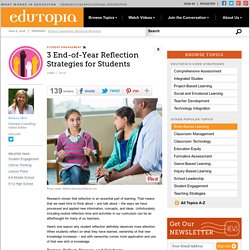
That means that we need time to think about -- and talk about -- the ways we have processed and applied new information, concepts, and ideas. Unfortunately, including routine reflection time and activities in our curriculum can be an afterthought for many of us teachers. Don’t Grade Schools on Grit. Still, separating character into specific strengths doesn’t go far enough.
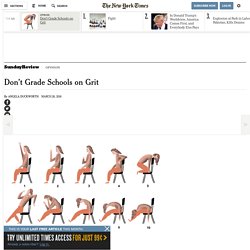
As a teacher, I had a habit of entreating students to “use some self-control, please!” Such abstract exhortations rarely worked. My students didn’t know what, specifically, I wanted them to do. In designing what we called a Character Growth Card — a simple questionnaire that generates numeric scores for character strengths in a given marking period — Mr. 3 Tips to Foster A Community of Growth Mindset Learners. As an educator, my hope is to develop joyful, self-directed, engaged learners.
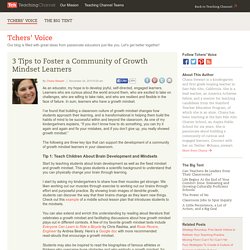
Learners who are curious about the world around them, who are excited to take on challenges, who are willing to take risks, and who are resilient and flexible in the face of failure. In sum, learners who have a growth mindset. I’ve found that building a classroom culture of growth mindset changes how students approach their learning, and is transformational in helping them build the habits of mind to be successful within and beyond the classroom. Edutopia. By objective measures, our young people are more anxious, more depressed, and have more psychopathology in general than students did a few decades ago. This has important implications for educators, school administrators, and society at large.
What if our traditional school systems are unwittingly contributing to the problem -- and what if a relatively simple practice could help? Sense of Failure As we are all well aware, the current educational system is narrowing its definition of what defines student success. It's almost all cognitive knowing, as evidenced by standardized testing. Edutopia. Day after day, I entered my psycho-physical education classroom at New Roads Middle School, primed and prepared to facilitate an inspiring lesson full of mindful practices. And day after day, I felt subtle disappointment as students stumbled in rowdy from recess and fumbled their way through the necessary task of moving the eight full-size tables and 25 chairs aside to make space for our work.
A chore that could take well under five minutes was eating up our class time and starting our class period with a raucous energy. Growth Mindset: Moving From I Can't To I Can't Yet. This is the first in Marion Ivey’s Getting Better Together series, Moving From I Can’t To I Can’t Yet. Marion and all the Teaching Channel Laureates are going public with their practice and seeking support in getting better from colleagues and the Tch community. Last year, on the first day of school, I asked my kindergarteners to draw self-portraits.
Four Strategies To Create A Culture of Success in Middle School. If you’ve ever taught middle school, you know it can be challenging. But you also know what a special place being in the middle can be. Middle schoolers enjoy laughter. Mindfulness in the Classroom. For me, it all started with a simple chime. That’s how I first implemented the core practice of breathing — on purpose — into my classroom’s daily routine. The chime was a simple, calming sound to alert the students it was time to breathe. Sure, I felt a bit silly asking kids to bow their heads and mindfully breathe, but I did it anyway and, with each passing day, the chime and breathing practice were just part of our classroom culture — a routine I looked forward to throughout the day. You can use a chime or any sound effect that unites the group for its mindful breathing moment — a quiet, peaceful mini-break that brings calm to the classroom.
Bonus: You may find, as I did, that it allows you to achieve a focused state of mind for your own thinking. Dr. Travis Bradberry. 6 Tips For Creating Effective Student Groups. Praise The Process Build A Growth Mindset. The Cycle Of Reflective Teaching. A Comprehensive Framework For Student Motivation.
Listing of Routines - A Culture of Thinking.